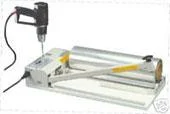Ad Code
Translate
List of 6,000+ Dofollow Commentluv Blogs FREE (Updated 2025)
January 16, 2025
What is Ozempic (semaglutide)? (Updated in 2025)
January 30, 2025
How To Find Suitable Properties In Cyprus? (Updated in 2025)
January 11, 2025
Smart strategies for trading on crypto exchanges
April 23, 2025
Understanding Heat Sealers And Appropriate Equipment
Khabza Mkhize
April 06, 2024
 The material of sealing material is essential to consider when choosing a sealer. It is also better to work with a supplier offering appropriate sealing material. This will make it easier to select a sealer that matches your material thickness and width. The right company will have representatives to guide you in choosing the most appropriate sealer for your material.
The material of sealing material is essential to consider when choosing a sealer. It is also better to work with a supplier offering appropriate sealing material. This will make it easier to select a sealer that matches your material thickness and width. The right company will have representatives to guide you in choosing the most appropriate sealer for your material. Types of heat sealer
Impulse sealers
An impulse sealer requires no warm-up and applies an energy pulse to your sealing area followed by immediate cooling. Impulse sealers get power when lowering the jaw. A suitable impulse sealer should use thermoplastic materials like polyethylene and polypropylene to ensure low seal temperatures. You can use an impulse sealer for purposes including:- Foil
- Pilofilm
- Polyflex
- Bubble packs
- Polyurethane
- Padded mailers
Impulse sealers are a good choice when choosing a heat shrink machine. These are easy to use, requiring no warm-up time, energy efficiency since electricity is only used in sealing, and safe since no component is always hot. Impulse sealers come in various types to handle multiple purposes and materials. The options of impulse sealers include:
- Hand sealers for 10mil material
- Foot sealers for 15mil material
- Automatic sealers for 15mil material
- Double impulse sealers for 20mil material
- Sealers with cutters and tubing for customized bags
Direct heat sealers
These sealers have jaws with constant heat. A direct heat sealer uses power when turned on. This gives it better heat penetration for sealing thicker materials. Direct heat sealers are ideal for materials including:- Gusset bags
- Waxed paper
- Cellophane
- Poly cello films
- Coated Kraft papers
- Coated aluminum foil
- Coated polypropylene
Types of sealers and appropriate equipment
Band sealers
These are for sealing pouches and come in vertical or horizontal models. Band sealers have a moving pair of bands that grasp the top of the package while moving it past the heat elements. A moving conveyor supports a heavy package, while the sealing bands hold lighter packages. You can get a model with a tilt feature that allows sealing the package with openings tilted upward to limit spillage.L Bar sealers
Used with shrink film, L bar sealers create three sealed edges made from the independent bottom and top webs or doubled-over length material. The sealer makes an end and edge seal for every cycle to create the “L” shaped seal. Each succeeding pouch comes out with an open side and end for a filling opening, which is sealed. This sealer comes with a cut-off device for separating packages. You can use the L bar sealer with shrink film and a heat tunnel.Clamshell sealer
These handheld devices add tamper resistance to food items such as sandwiches and salads sealed in self-locking clamshell preforms. Also called point sealers, these sealers use heat or sound waves to make a tiny melted tack weld in the packaging material. You can use clamshell packages for sealing on blister sealers requiring perimeter sealing.Vacuum sealer
Items such as food and meat require packaging to limit them from spoilage. Vacuum sealers keep low oxygen in the package. These sealers have a chamber for evacuating oxygen from the tray or package before sealing and placing the cover. You can select an automatic, semi-automatic, or manual vacuum sealer depending on your packaging requirements. You can also get a vacuum sealer for modified atmosphere packages.Blister sealer
These are sealers for attaching thermoformed blisters on film backings and paperboard. Blister sealers can handle a single package for each cycle with manual shuttle units. Other options include automated rotary-type sealers and automated sealers with mechanical loading of blisters, cards, and products. Unlike other machines that also form packages, a blister sealer is for only sealing.Crimp sealers
Crimp sealers are the ideal solution when sealing a pouch at a time. Crimp sealers are handheld or bench-mounted. Like crimp sealers, jaw sealers are bench or floor-mounted with more considerable sealing lengths and footswitch actuated. However, you can set it in automatic mode to allow packages to be fed into seal bars needed to actuate their closing.
Conclusion
Using the most appropriate packaging for your products is very important to make them appealing to potential customers. Heat sealing is a popular solution for meeting various packaging requirements in a business. However, you must invest in appropriate sealing equipment to match your needs and budget.Featured Post
12 Prominent new technologies and trends emerging in 2025
Khabza Mkhize-
April 02, 2025
Soapie Teasers
Sister Sites
Most Popular
List of 6,000+ Dofollow Commentluv Blogs FREE (Updated 2025)
January 16, 2025
Smart strategies for trading on crypto exchanges
April 23, 2025
Popular posts
List of 6,000+ Dofollow Commentluv Blogs FREE (Updated 2025)
January 16, 2025
Smart strategies for trading on crypto exchanges
April 23, 2025
Footer Menu Widget
Created By Blogspot Theme | Distributed By Gooyaabi Templates


Social Plugin